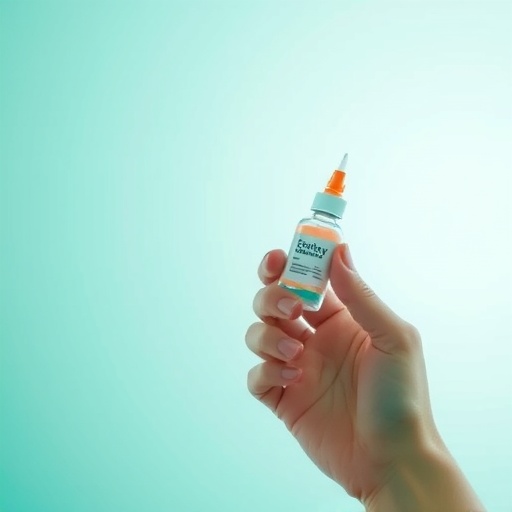
In a groundbreaking clinical trial conducted at Saarland University Medical Center, researchers have unveiled compelling evidence that an over-the-counter azelastine nasal spray markedly reduces the risk of SARS-CoV-2 infection. Spearheaded by Professor Robert Bals, Director of the Department of Internal Medicine V, the study represents a significant leap forward in our understanding of accessible prophylactic interventions against respiratory viruses. The randomized, double-blind, phase 2 trial enrolled 450 participants, meticulously dividing them into treatment and placebo arms to evaluate the protective efficacy of azelastine administered thrice daily over nearly two months.
The study’s design was meticulous in its execution. Participants in the treatment group, numbering 227 individuals, received azelastine nasal spray three times daily for 56 days, a regimen mirrored by the placebo group of 223 subjects with an identically administered saline spray. Throughout this period, incidence rates of SARS-CoV-2 infections were closely monitored, with PCR confirmation ensuring robust diagnostic accuracy. The findings were striking: only 2.2% of those in the azelastine cohort contracted the virus, compared to 6.7% in the placebo group—a nearly threefold reduction, underscoring azelastine’s notable protective effect.
Beyond the primary endpoint of SARS-CoV-2 prevention, the study also assessed symptomatic disease expression and the broader spectrum of respiratory viral infections. Participants receiving azelastine not only showed fewer symptomatic COVID-19 cases but also exhibited a lower overall incidence of respiratory infections during the study period. Remarkably, the treatment group’s vulnerability to rhinovirus—another major respiratory pathogen—was reduced to a similar extent. Only 1.8% of individuals using azelastine developed rhinovirus infections against 6.3% in their placebo counterparts, hinting at azelastine’s broader antiviral properties beyond coronaviruses.
Historically, azelastine has been utilized primarily as an antihistamine nasal spray to alleviate allergic rhinitis symptoms such as hay fever. However, emerging in vitro studies have demonstrated its potential antiviral activity, especially against respiratory viruses like SARS-CoV-2. This clinical trial provides the first substantive real-world evidence validating these antiviral effects. Professor Bals emphasized, “Our clinical data confirm the promising in vitro antiviral indications, placing azelastine as a potential frontline defense in viral respiratory illness management.”
The mechanism by which azelastine exerts these antiviral effects remains an area of intense investigation. Preliminary hypotheses suggest that azelastine may inhibit viral entry or replication through modulation of nasal mucosal immunity or direct interference with viral particles. These actions may disrupt the initial stages of infection, reducing both viral load and transmission potential. Understanding these antiviral pathways in finer detail could unlock new avenues for prophylaxis in respiratory viral diseases.
The broader implications of this study are profound, especially considering the ease of accessibility and safety profile of azelastine nasal spray. As an already approved medication familiar to millions worldwide, its repurposing as a protective agent against respiratory viruses could be swiftly integrated into public health strategies. Professor Bals envisions azelastine as an “additional, easily accessible prophylactic tool complementing vaccines and masks, particularly crucial during periods of high viral transmission or for immunocompromised individuals.”
Despite these promising results, the investigators exercised caution by calling for further validation through larger, multicenter trials. Expanding these findings across diverse populations and varying viral variants will be essential to robustly establish azelastine’s clinical utility. Furthermore, the trial underscores the importance of exploring azelastine’s efficacy against a broader panel of respiratory pathogens, potentially positioning it as a versatile agent in respiratory disease prevention.
The trial, dubbed ‘CONTAIN,’ exemplifies a synergistic collaboration between academia, industry, and public health sectors. Alongside Professor Bals, teams from Saarland University’s Institute of Clinical Pharmacy and Institute of Virology contributed critical expertise. The pharmaceutical company URSAPHARM Arzneimittel GmbH sponsored and manufactured the investigational product, while the Helmholtz Institute for Pharmaceutical Research Saarland provided instrumental research support. This multifaceted partnership highlights the value of integrated approaches in translating promising laboratory research into viable clinical interventions.
From a public health perspective, the prospect of an over-the-counter nasal spray that reduces infection risk by nearly threefold is a paradigm shift. It offers a non-invasive, self-administered, and cost-effective adjunct to the existing arsenal against respiratory pandemics. In scenarios where vaccine coverage is insufficient, or where emerging variants threaten vaccine efficacy, azelastine nasal spray could fill critical protection gaps, especially in vulnerable populations such as the elderly or immunosuppressed.
Moreover, azelastine’s observed efficacy against rhinovirus infections opens intriguing possibilities for broader applications. Rhinoviruses cause a substantial global burden of respiratory illnesses and exacerbate conditions such as asthma and chronic obstructive pulmonary disease (COPD). An agent that could mitigate these infections would have substantial clinical and economic impact, reducing healthcare utilization and improving quality of life.
The trial methodology deserves particular commendation for its rigorous double-blind, placebo-controlled design, minimizing bias and enhancing the reliability of outcomes. Participants were monitored carefully, and any infections were confirmed by PCR diagnostics, providing objective data points. This level of rigor bestows confidence in the translational relevance of the results to real-world settings, maximizing their potential public health impact.
The delivery method via nasal spray targets the nasal mucosa, a primary portal of viral entry in respiratory infections. This localized administration facilitates high local concentrations of azelastine at the mucosal surface, enhancing antiviral action precisely where the virus first establishes infection. Such targeted approaches may prove superior to systemic therapies by minimizing side effects while maximizing effectiveness.
In the context of the relentless evolution of SARS-CoV-2, with emerging variants continually challenging vaccination and therapeutic strategies, the development of additional preventive tools is paramount. Azelastine nasal spray presents an innovative, readily deployable option that can be rapidly scaled and distributed without the logistical complexities of novel drug development and approval processes.
Taken together, the CONTAIN trial heralds an exciting new chapter in respiratory infection prevention. Its results not only reinvigorate interest in repurposing familiar drugs for emergent global health crises but also demonstrate the power of collaborative research to deliver timely, impactful medical innovations. As this line of investigation progresses, azelastine nasal spray could soon become a cornerstone in the multipronged defense against respiratory viral infections worldwide.
Subject of Research: People
Article Title: The CONTAIN Study Group. Azelastine nasal spray for prevention of SARS-CoV-2 infection: a phase 2 randomized clinical trial.
News Publication Date: 2-Sep-2025
References: DOI 10.1001/jamainternmed.2025.4283
Image Credits: Laura Gluecklich/Saarland University Hospital
Tags: Azelastine nasal spray effectivenessazelastine treatment group outcomesclinical trial on respiratory virusesimpact of azelastine on respiratory infectionsincidence rates of coronavirus infectionsnasal spray for virus preventionover-the-counter COVID-19 treatmentsphase 2 randomized controlled trialpreventive measures against respiratory virusesProfessor Robert Bals research findingsprophylactic interventions for COVID-19SARS-CoV-2 infection reduction




